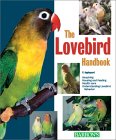Senegal Parrots
 Origin: African continent (central-western)
Origin: African continent (central-western)
Species: Poicephalus senegalus
Senegal parrots are medium (not much bigger than cockatiels) sized parrots that can make excellent pets. They do mimic, but are more adept at sounds than clear speech. They are generally quieter parrots, but they definitely can let out a screech when excited. They can make good apartment birds as noise is rarely a problem. Hand-fed, well-socialized babies (completely weaned) are your best bet. There is some contention that senegals can develop phobias later in life, so it is a good idea to expose them to new things from an early age so they are used to some change.
Be careful about carrying the bird about on your shoulder outside. They can get great distances with just a few flight feathers and can at times spook very easily. Many a senegal has been lost this way.
Caging: Medium-sized cage that is big enough to allow lots of climbing. Senegals like to climb and hang upside down at times. Add lots of perches and plastic chains for climbing.
Diet: medium hookbill seed, medium pellets, fresh vegetables, some fruit, figs, corn, sprouts, and grains. Give a varied diet to keep the bird interested and also to avoid food “phobias”. Generally good eaters who will accept new foods readily.
Health: Very robust birds. Not prone to feather plucking. Enjoy regular human interaction, but also can play independently.
Noise: Not particularly noisy. They can make an extremely loud screech at times, but they do not have a reputation for becoming screamers. They will usually send out one loud screech then quiet down. They will learn to imitate the natural calls of other birds in the house (or outside) with ease.
Sleep: At least 10 hours of darkness and quiet. A tv in the room does not equal good sleep.
Sexual behavior: Can become aggressive and sometimes phobic after reaching sexual maturity. Most major problems can be avoided by developing a strong relationship early on and using gentle dominance techniques. It is a good idea to expose the bird to new things on a regular basis early on and throughout its adulthood so it learns to adjust.
Breeding: Large suspended cages work best. Males can become aggressive toward hens, so give enough room for her to move away from him. Best left to experienced breeders.










